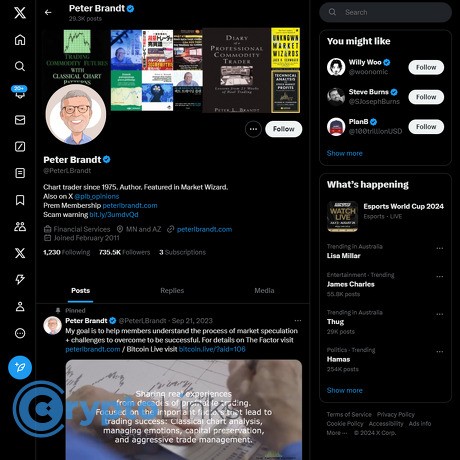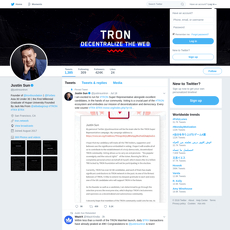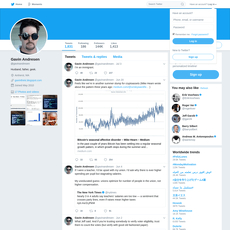Peter Brandt Review
Peter Brandt
x.com
Peter Brandt review guide: what to expect (and how to actually use it)
Can following Peter Brandt on X actually make you a better crypto trader—or does it just crank up your FOMO and cut your PnL in half?
I’ve followed Brandt through bull runs, rug-pulls, and those quiet stretches where BTC just grinds sideways. He’s one of the few voices I keep on my shortlist. But here’s the catch: if you scroll his feed and slap on trades without a plan, you’ll turn solid chart wisdom into avoidable losses.
This guide shows you how to use his posts the right way: what to focus on, what to ignore, and a simple, repeatable plan you can actually follow without babysitting charts all day.
The real problem: too many charts, not enough process
Most people see a clean Brandt chart, feel that itch, hit market buy, and then spend the next 48 hours refreshing the chart like it owes them money.
Three common traps I see all the time:
- Timeframe mismatch: Brandt posts a weekly structure; you trade it on a 5-minute chart. That’s not a strategy—that’s roulette.
- No invalidation: You enter on the “idea” but don’t define where the setup is wrong. Without a stop, there’s no edge—just hope.
- Oversized risk: A 10x leveraged guess because the chart looks “obvious.” When it works, it feels genius. When it doesn’t, you’re back to square one.
Reality check: In markets, even great setups fail. Small risk keeps you in the game. Big risk makes sure you won’t see the next good setup.
There’s plenty of research backing a slower, rules-first approach. For example, Barber and Odean’s well-known study on individual traders found that higher trading activity typically leads to worse performance after costs—overconfidence and FOMO are expensive habits. Keeping risk per trade small (think ~1–2%) dramatically cuts the odds of ruin, a principle echoed in classic risk-of-ruin math and widely taught by risk experts like Van Tharp. Translation: the boring stuff saves accounts.
Promise solution
Here’s what you’ll get from this series: I’ll show you who Brandt is (beyond the tweets), how his chart logic actually works, and the risk rules that make his approach durable. You’ll learn how to follow his feed without getting whipsawed—and how to build a simple checklist you can run on autopilot.
Think practical, not theoretical. Less “hot takes,” more “here’s how to act.”
What this guide covers
- His background and why his approach still matters in crypto
- Risk ideas that actually protect your stack (including the ~1–2% risk approach)
- The 3–5–7 framework: a clean way to cap risk and aim for favorable outcomes
- The Donchian/Brandt weekend rule and when it adds useful context
- How to read his X posts without chasing every line he draws
- Pros and cons—who should follow him and who shouldn’t
- Fast answers to common questions so you can avoid rookie mistakes
Quick example of using his feed the right way:
- He posts: “Weekly BTC ascending triangle, breakout above 72k. Invalidation below trendline.”
- Your plan: Set an alert at 72k and at the invalidation level. If price triggers, risk 1% max. If the breakout fails, exit—no debate.
- What you skip: Guessing the move ahead of the trigger, adding size “because it looks strong,” or mixing it with three other random opinions.
The difference is subtle but huge: you’re not trading his tweet—you’re trading your rules, using his levels for structure. That’s where the edge lives.
So why do so many crypto traders still listen to Peter Brandt after all these years—and what makes his charts different from the endless noise on your feed? Let’s tackle that next.
Who is Peter Brandt and why crypto traders still listen
When I want a clean read on trend and risk, I check Peter Brandt’s feed. Not because he’s always right—no one is—but because his process is older than most crypto cycles and still punches through noise. He’s been trading since bell-bottoms were a thing, and the markets have tried to kill him a hundred different ways. He’s still here.
“It’s not what you trade, it’s how you trade it.” — Peter Brandt
Brandt in a nutshell
Quick facts that matter when you’re deciding whose chart to trust:
- Started in 1976 at ContiCommodity Services; launched Factor LLC in 1980 to trade proprietary capital.
- Built a career across commodities, futures, FX, and equities—then brought the same approach to crypto.
- Known for classical charting: breakouts, head-and-shoulders, triangles, channels, and parabolic advances.
- Wrote the trading memoir/manual Diary of a Professional Commodity Trader, a book many traders keep on their desk for the risk chapters alone.
- Public about the boring stuff most skip: position sizing, invalidation, and record-keeping.
Brandt’s edge isn’t a secret indicator or a magic timeframe. It’s a rule-based lens for reading price that makes you ask, “Where am I wrong?” before you ever ask, “How much can I make?” That shift alone saves accounts.
What he’s known for (beyond crypto)
He cut his teeth in markets that don’t care about your feelings—think sugar, soybeans, cattle, currencies. That’s where he learned the value of clean structures and clear exits. He brought that discipline to Bitcoin and alts long before it was fashionable.
Here’s what stands out when you watch him over time:
- Probability over prediction: He posts “if/then” scenarios, not gospel calls. If price breaks a neckline, then risk opens up. If it fails, he’s out. No drama.
- Parabolic awareness: He’s hammered the same lesson for years—when a parabola breaks, the typical outcome is a deep and extended drawdown. In 2018, that thinking helped many avoid the worst of Bitcoin’s collapse after the vertical advance cracked.
- Transparency: He shows his invalidations publicly. When he’s wrong, he says so. That’s rare and valuable because it teaches you how to take a loss without wrecking your plan.
- Hype filter: He’ll call out manias, “laser-eye” moments, and narrative fever. If the chart structure doesn’t back the story, he doesn’t care about the story.
If you want the research lens behind why this approach works, there’s support for it. Time-series momentum—basically the math behind “let winners run, cut losers”—has been documented across asset classes for a century. A well-known paper by Moskowitz, Ooi, and Pedersen (Journal of Financial Economics) showed momentum effects in dozens of futures markets. Classical pattern stats have also been cataloged for years; traders like Thomas Bulkowski built large databases suggesting many breakouts can have a positive expectancy when paired with proper stops and measured move targets. Brandt’s style sits right where those ideas overlap: structure plus strict risk.
None of this says every pattern pays. It says a consistent method with defined exits and sensible bet size can work across markets and decades. That’s the point.
Why crypto folks care
Crypto is a fireworks show. It rewards patience one month and punishes it the next. So why do traders—from hardened futures guys to weekend BTC stackers—still listen to an old-school technician?
- Same rules, new playground: He doesn’t change his stripes for crypto. A weekly triangle is a weekly triangle. A failed breakout is a failed breakout. That consistency helps you avoid chasing headlines.
- Risk-first mindset that travels well: Whether it’s soybeans or Solana, he sizes small and cuts quick. Watching his posts trains you to think in invalidation first, not targets.
- Clean levels for big money decisions: If you hold spot, his levels help you avoid adding into obvious traps. If you trade, they give you objective triggers—no need to guess.
- Peace of mind: Crypto’s worst drawdowns start with a broken structure that was visible to anyone willing to look. He makes those structures obvious. Sometimes the best “win” is the loss you didn’t take.
I’ve seen the same pattern play out for readers again and again: once you start thinking in Brandt’s if/then language, FOMO cools down and decision-making gets calmer. That’s not just good for your PnL. It’s good for your sleep.
Curious how to take this from biography to blueprint—what he actually looks for on charts, how he caps risk per trade, and the specific weekend behavior he watches when Bitcoin presses the highs? Keep going; that’s exactly what’s next.
How Brandt actually trades: charts, rules, and risk
You don’t need a magic indicator to understand how he works. You need rules, a clean chart, and a way to size risk so you can sleep at night. That’s the backbone. Patterns are just the vehicle.
“Survive first. Compound second.”
Risk management (the core)
Brandt’s style makes sense because it’s built on small, repeatable risk. Think 1–2% of your total capital per idea. It’s not exciting, but it’s how you avoid turning one bad week into a lost year.
Here’s how I translate that into action:
- Pick your “sleep-at-night” number: 1% risk per trade is conservative. 2% is still disciplined. More than that and your emotions start trading for you.
- Size with a calculator, not your gut: Position size = (Account x Risk %) / (Entry - Stop).
Example: Account $10,000, risk 1% = $100. BTC long at $60,000, stop $57,000 (risk $3,000 per BTC). Position ≈ $100 / $3,000 = 0.0333 BTC. Notional ≈ $2,000. If you’re wrong, you lose ~$100. You’ll live to try again. - Accept losing streaks as math, not drama: Ten straight losses at 1% risk is ~9.6% down. At 2% risk, it’s ~18.3% down. Still survivable. Blow-ups come from oversized bets, not bad luck.
- Backed by proven concepts: Keeping risk small slashes your risk of ruin and keeps expectancy positive over time. See ideas like position sizing and risk-of-ruin in plain English here:
Risk of Ruin,
Kelly Criterion (intuition, not a mandate).
When I follow this, I’m calm. When I ignore it, the market reminds me why it exists.
The 3-5-7 rule explained
This is a practical framework many traders use alongside a conservative approach:
- 3 = cap risk at ≤3% per trade (I still prefer 1–2% as default).
- 5 = keep combined open risk ≤5% across all positions.
- 7 = aim for winners that are meaningfully larger (around +7% or better) than your average loser.
Why it works: it narrows the worst-case damage and forces an edge. Expectancy is the whole game.
Simple expectancy check: E = (Win rate x Avg win) – (Loss rate x Avg loss)
- Say you win 40% of the time.
- Average win = +7%, average loss = -3%.
- E = (0.40 x 7) – (0.60 x 3) = 2.8 – 1.8 = +1.0% per trade (over a large sample).
Portfolio example: Three setups line up. You risk 1.5% on each. That’s 4.5% total open risk (within the 5% cap). If two fail (-3% total) and one hits +7%, you’re still +4%. That’s how small losses and occasional bigger wins stack in your favor.
The Donchian/Brandt weekend rule
One useful observation: when price pushes to fresh highs on a Friday close, momentum can carry into next week. It’s not a guarantee—just a tailwind.
- Context, not a trigger: If BTC closes Friday at a new 20-day or weekly high, I’ll prep a plan for Monday rather than chase late on Friday.
- How I use it: Set an alert slightly above Friday’s high. If Monday pulls back and reclaims, I’ll consider the entry with the stop below Friday’s low. Risk still ≤1–2%.
- Donchian logic: New-high closes reflect trend strength; breakouts often follow through. Read about the channel concept here:
Donchian Channels.
Again: it’s an extra gust of wind in your sails, not the sail itself.
Timeframes and setups
He favors patterns that survive the noise: weekly and daily structures with clean invalidation. Think breakouts from ranges, triangles, and classic reversal patterns where the line in the sand is obvious.
- Structure first: No pattern, no trade. If you can’t circle the setup and the stop on a screenshot in 10 seconds, it’s not clean.
- Breakout clarity: Look for multiple touches on boundaries (at least 3), tight consolidation into the break, and expanding volume on the move.
- Invalidation over opinion: Your stop lives just beyond the structure that proves the idea wrong (below the base of a rectangle, outside a triangle apex, etc.). If it breaks, you’re out—no debate.
- Measured moves as a guide: Range height ≈ potential target after a breakout. It’s a guide, not a promise. Take partials on the way if your plan says so.
Example routine, start to finish:
- Spot a daily rectangle on ETH with a clear ceiling and floor.
- Plan: buy the close above the range high or a retest of that level. Stop below the opposite edge or the last higher low.
- Size: Account $25,000, risk 1.5% = $375. If entry 3,200 and stop 3,040 (risk $160 per ETH), position ≈ 2.34 ETH.
- Manage: if it stalls back inside the range, cut immediately. If it runs, trail under higher lows; consider partials at 1R, 2R, or the measured move.
When you operate like this, emotions get quieter. Your stop becomes a seatbelt, not a suggestion. You don’t need to be right; you need to be systematic.
So what happens when you open his feed and see three charts, two hot takes, and a sharp comment about trend strength? How do you turn that into alerts and a clean plan without FOMO? That’s up next—I’ll show you exactly what to look for, what to ignore, and how I turn his posts into trades I can actually manage.
Reviewing his X account: what you’ll see and how to use it
Content style
When you follow Peter Brandt on X, expect clean charts, direct language, and clear “if/then” thinking. He posts potential patterns with lines that matter, points out invalidation levels, and often highlights the higher timeframe so you’re not tricked by noise. No hype. No spoon-feeding entries. Just structure.
Typical post flow you’ll notice:
- Context first: Weekly or daily chart, not 5‑minute chaos.
- Conditional language: “If price does X, then the pattern is valid; if Y, invalid.”
- Clean invalidation: A level where the idea is wrong—so you don’t debate the stop.
- Occasional sarcasm: He’ll call out herd behavior when the crowd is euphoric or panicked.
“The market doesn’t care about your opinions.”
That line hits because it’s true. Your account listens to risk, not feelings.
Signal vs. noise
Not every chart he posts is a trade for you. Your edge is picking the signal and discarding the rest.
- Signal: Higher timeframe patterns with clear levels (breakouts, retests, failed patterns) and a posted invalidation. These give you ready-made lines to stress-test your own plan.
- Noise: Casual comments, quick jabs at sentiment, or charts posted without a trigger/invalidation. These are context, not calls.
Why this filtering matters: research shows attention-driven trading leads to worse outcomes. Barber & Odean (2000) found that frequent traders underperform due to overactivity and attention biases. Add social feeds and it’s gasoline on that fire—studies have linked social media excitement with short-lived, volatile moves in crypto prices (for example, Bollen et al., 2011 on sentiment and returns; see also work on crypto herding/attention in SSRN and academic journals). In short: reacting beats you; planning saves you.
Links worth a quick read:
- Barber & Odean: Trading Is Hazardous to Your Wealth
- Bollen et al.: Twitter Mood Predicts the Stock Market
A simple way to follow without FOMO
I use his posts as a checklist, not a trigger. Here’s the simplest path that actually works:
- Save the chart: Screenshot or bookmark the post. Note the key levels and invalidation he marked.
- Set alerts: Put alerts at the breakout trigger and the invalidation. No alert, no action.
- Predefine risk: Decide your risk per trade before price gets there. I write it down: “Risk $R if trigger hits; cancel if invalidation prints first.”
- Act only on alignment: If your system rules line up with his levels, you have a trade. If not, it’s just a useful chart to watch.
Concrete example you can copy today:
- He posts BTC forming a clean range with a marked breakout level and an invalidation at the prior swing low.
- You set two alerts: one slightly above the breakout; one at the invalidation.
- You pre-calc size so your stop at invalidation risks a fixed dollar amount (not a guess).
- If breakout alert fires during your trading window and volume is healthy, you execute. If invalidation hits first, the idea is dead—no “maybe it bounces.”
Pro tip: Writing a tiny “if/then” plan reduces impulse. Behavioral research on implementation intentions shows a small plan (“If X, then I do Y”) cuts knee-jerk reactions and helps you stick to rules under stress.
How I evaluate his calls on crypto
I don’t “agree” or “disagree” with a chart. I test it. My fast filter:
- Market structure: Is price breaking a clear weekly/daily level or just chopping mid-range?
- Volume behavior: Breakouts with expanding volume have a better chance of follow-through. (Pattern stats from resources like Bulkowski’s database consistently show volume confirmation matters.)
- Trend alignment: Does the setup align with the higher timeframe trend, or is it fighting it?
- Macro/flows: Are risk assets broadly supportive today/week (DXY, yields, liquidity, major catalysts)? I don’t need a green light on everything, but I don’t want a red one.
My rule of thumb: if at least three boxes tick, I consider it tradable. If not, I pass—even if the chart is pretty. A pretty chart without alignment is how P&Ls leak.
Quick green flags I look for:
- Clean invalidation: The stop is obvious. No debate = faster execution, smaller slippage.
- Priority level: Weekly or multi‑month range boundary. Bigger levels, bigger edges.
- Fresh momentum: Range break with strong close and participation, not a lonely wick.
And red flags that make me skip:
- Mid-range entries: Reward is capped, risk isn’t.
- Ambiguous stops: If I can’t place the stop without “feeling,” I’m out.
- Event landmines: Major policy decisions or listings within hours that can negate the pattern.
If you want one simple sanity check, use this: “Would I still take this setup if Peter never posted it?” If the answer is no, you’re chasing a personality, not a process.
Here’s the real question: who actually benefits from following him—and who won’t? In the next part, I’ll lay out the pros, the cons, and exactly which types of traders should keep him on their screen (and which shouldn’t). Want a hint? Patience pays, but not for everyone.
Pros, cons, and who should follow Peter Brandt
I care less about hot takes and more about what actually helps me protect capital and capture the meat of a trend. That’s why I keep Peter Brandt on my screen. If you’re wondering whether his work fits your style, here’s the straight-up view from using his posts in real time.
Pros
What I like—and why it matters:
- Decades in the trenches. He’s traded through booms, busts, and the noise in between. That kind of mileage tends to filter out flashy setups and leave only what’s repeatable.
- Risk-first, not narrative-first. He consistently frames ideas with invalidation. That alone can stop you from turning a small loss into a disaster.
- Pattern clarity on higher timeframes. Clean structures—weekly triangles, classical breakouts, head-and-shoulders—are easier to risk around and harder to fake. Crypto volatility makes this a real edge.
- Educational by example. Even when you don’t trade his view, you learn to spot proper breakouts vs. noisy range pokes. Save his charts, note the invalidation, and watch how price behaves around those levels.
- Transparency when he’s wrong. No guru act. Seeing what a veteran calls a failed pattern teaches you how to exit without drama.
Quick sample from my logs: During a BTC range in 2022, he posted a clean horizontal level with a clear “below here, pattern fails” tone. I didn’t take the breakout, but I used that line to avoid long exposure in chop. Saved me from two fake moves that would’ve cost far more than they were worth. That’s the kind of secondhand edge that compounds.
Why this style has support beyond anecdotes:
- AQR’s “A Century of Evidence on Trend-Following Investing” finds time-series momentum has worked across assets and decades. Brandt’s breakout-and-risk approach rhymes with that logic.
- Brock, Lakonishok, and LeBaron (1992) showed simple technical rules carried information value beyond randomness. Not crypto-specific, but useful context for rule-based charting.
- Bulkowski’s Pattern Research tracks win rates and failure modes for classical patterns. While crypto is wilder, the discipline of pattern + stop + measured move is still a practical scaffold.
“Protect your capital first; profits show up when they have a safe place to land.”
Cons
What might not work for you:
- No step-by-step babysitting. If you want exact entries/exits spoon-fed, you won’t get them. You need your own triggers and position sizing.
- Feels slow for scalpers. Higher-timeframe patterns unfold over days or weeks. If you’re hunting five-minute adrenaline, you’ll get impatient and force trades.
- He’s human—and public. Any veteran will be wrong sometimes. If you copy without your own stop, you’re volunteering to pay tuition to the market.
- Classical setups can fail fast in crypto. Structural breaks and weekend whipsaws happen. Without a hard invalidation and small risk, this can sting.
Real talk: The worst outcomes I see come from people mixing his weekly view with their intraday urges. If you act on a weekly pattern but manage it with five-minute emotions, you’ll chop yourself to pieces.
Who gets the most value
- Swing traders who want clean levels, clear invalidation, and patience.
- Trend followers who judge trades by risk and structure, not predictions.
- Long-term crypto holders who want better adds/trims and protection from ugly drawdowns.
Maybe not your cup of tea if: you’re a pure scalper or you need constant high-frequency signals. His edge is process and structure, not speed.
Other resources I like to pair with his feed
Keep it tight, useful, and not overwhelming:
- TradingView — Set alerts right at his levels and your invalidations. Keeps you from staring at screens.
- Bulkowski’s thepatternsite — Quick refreshers on classical patterns, common failure points, and measured targets.
- AQR Trend-Following paper — Confidence booster for sticking with rules when Twitter gets loud.
- Donchian Channels — Useful for visualizing breakout context around weekly highs and lows.
- StockCharts ChartSchool (Patterns) — Straightforward explanations to standardize your playbook language.
- Glassnode Studio (optional) — If you like a macro on-chain layer, pair structural chart levels with simple on-chain trend metrics.
Want the fast, no-BS answers everyone asks about his rules, risk caps, and weekend breakouts? I’m breaking those down next—what the 3-5-7 idea actually means, how to size risk without overthinking, and when that Friday breakout tailwind helps vs. hurts. Ready for the cheat sheet?
FAQ: quick answers people ask about Peter Brandt and his rules
What is the 3-5-7 rule in trading strategy?
Short version: it’s a simple guardrail for risk and reward.
- 3 = risk no more than ~3% of your account on any single trade.
- 5 = keep total open risk across all trades ≤5% of your account.
- 7 = aim for winners that beat losers by roughly 7% or better (think positive expectancy, not perfection).
How I use it in practice:
- Single-trade risk example: $10,000 account → 3% risk cap = $300 max loss per trade.
- Portfolio risk example: if you already have $200 at-risk on Trade A and $200 on Trade B, you’ve used $400 (4%). You can only add another $100 of risk before hitting 5%.
- Payoff targeting: if your stop is $300 away, look for a structure that offers ~$700+ potential, or skip it.
Why it works: rules like this force you to size correctly and skip mediocre setups. That’s directly in line with Brandt’s risk-first mindset even if it’s not his personal formula. It keeps small losses small and lets a few solid trends carry the account.
What is Peter Brandt known for?
He’s a veteran trader who made his name long before crypto:
- CEO of Factor LLC (since 1980), trading proprietary capital.
- Classical charting: breakouts, head-and-shoulders, triangles, broadening tops/bottoms—clean patterns on higher timeframes.
- Process over predictions: transparent when wrong, strict with invalidations, and focused on probabilities.
- Risk discipline: small per-trade risk, controlled portfolio exposure, and exits where the pattern is invalid.
“Trade the pattern, honor the stop, next.” — the spirit of Brandt’s approach
What is the Donchian weekend rule?
Idea: when a market breaks to fresh highs on a Friday close, momentum often continues into the following week. It’s an observation popular with trend followers (Donchian/Turtle-style thinking), not a guarantee.
How I think about it:
- Use it as a tailwind, not a trigger. You still need a valid setup, clear invalidation, and position sizing.
- Crypto trades 24/7, so “Friday” is more behavioral than structural. But it still lines up with how traders pile in when a clean breakout prints before the weekend.
- Example context: late October 2023, BTC pressed above prior range highs into the weekend and extended early the next week toward the mid-30Ks—classic momentum follow-through. Not every Friday breakout behaves, but many trend legs start just like that.
Background worth knowing: classic breakout/Donchian concepts underpin a ton of trend-following research. Studies on time-series momentum (e.g., Moskowitz, Ooi, and Pedersen, 2012) show that assets making new highs tend to keep trending on medium-term horizons. That’s the logic behind treating Friday breakouts as a potential wind at your back.
What is Peter Brandt’s approach to risk management?
Keep risk small, let invalidation kick you out, and avoid stacking too much correlated exposure. In plain English:
- 1–2% per trade is a common range he references. That keeps losing streaks survivable.
- Let the chart define the stop: below the breakout level for longs, above it for shorts, or just beyond the pattern boundary that proves you wrong.
- Position sizing formula: Position size = (Account risk $) ÷ (Stop distance $).
Real-world example:
- Account = $25,000; per-trade risk = 1% → $250.
- BTC long with a $500 stop distance → position size = $250 ÷ $500 = 0.5 BTC exposure (adjust with contracts/spot sizing).
- If the stop hits, you lose ~$250. If the trend runs, you have room to scale or trail without panicking.
Why I stick to this: small risk per idea keeps me calm enough to follow the plan. It’s the only way those bigger trend wins can show up without earlier losses nuking the account.
Want to see exactly how I turn these rules into an executable crypto workflow? In the next section, I’ll share my checklist, my alert setup, and how I decide “enter” vs “pass” in under 60 seconds. Ready to make this real on your charts?
How I use Brandt’s work in my own crypto process
I don’t treat charts on social as trade signals. I treat them as structure. When I see a clean pattern and a clear invalidation on a post, I translate that into one question: what’s my risk and what has to happen for me to be wrong fast?
My checklist
Spot the pattern and the line in the sand
If I can’t point to the invalidation in 5 seconds, I pass. For breakouts, that’s usually the range low or the last swing low. For failed patterns, I’m out on a recapture or close back inside the range. No “let’s see what happens.”
Set alerts at the trigger, not the idea
I place alerts a touch above/below the levels that matter. I don’t stare at screens waiting. If price never tags, I never trade. Missed trades are free.
Size to ≤1–2% risk
Position size is reverse-engineered from the stop. If my stop is 3.5% away and I’m risking 1.25% of equity, I size so a full stop is -1.25%. That’s it. No “confidence” adjustments.
Enter on confirmation, not anticipation
I enter on the trigger I defined beforehand (breakout close, retest, or a rule like “hourly close above X with above-average volume”). If the trigger doesn’t happen, I don’t invent a new one mid-trade.
Manage by R, not dollars
I plan in R multiples (risk units). First scale at +2R if momentum is hot, move stop to breakeven, then trail using a simple rule (10-day low or ATR stop). If market is choppy, I’ll take full profit near +2R and stand down.
Journal the cause and the effect
One note on what I took from the chart post (pattern, level, invalidation), one note on what my rules added (risk, trigger, management), one screenshot before/after. That’s enough to learn and repeat.
Why this works: trend and breakout rules have a long track record across markets. If you want the receipts, check AQR’s research on time-series momentum showing broad, persistent edges in simple trend-following rules (AQR, 2012). Keeping risk small also slashes the chance of blowing up—see “risk of ruin” basics. And journaling/reflecting improves performance in lots of domains; one study found guided reflection boosted results by ~20% (HBS Working Paper).
My rule of thumb: if I can’t define the trigger, the stop, and the first target before I place the order, I don’t place the order.
Two quick examples
BTC breakout through the former ATH (March 2024)
- Context: BTC was pressing the old 2021 high. Structure was clean on the daily/weekly.
- Trigger: hourly close above 69,500 with rising volume vs. 20-hour average.
- Risk: stop at 65,800 (below the prior swing), risk 1.25% of account.
- Management: took 50% at +2R, trailed the rest with a 10-day low.
- Outcome: booked +2.1R on the first scale and +0.3R on the runner as the trail got hit. Total ≈ +1.4R. Clean, boring, repeatable.
Altcoin wedge that failed (recent range market)
- Context: contracting range into resistance, plenty of overhead supply.
- Trigger: breakout close above the wedge—took it per plan.
- Risk: stop under the last higher low, 1.0% account risk.
- Outcome: immediate fade back into the range. Stopped for -1R. No re-entry; I wait for a fresh setup.
One win, one loss. The win was bigger than the loss. That’s the whole game.
Mistakes to avoid
- Trading opinions instead of levels. If a post changes your bias but not your plan, you’re exposed.
- Skipping the stop “just this once.” The market remembers. Your account won’t.
- Timeframe drift. Seeing a weekly pattern and managing it like a 5-minute scalp is how good ideas die.
- Revenge sizing after a win or a loss. Barber & Odean’s famous paper shows overtrading crushes returns (Journal of Finance, 2000).
- Front-running weekend breakouts. I treat Friday strength as a tailwind, not a trigger. I still need my level and my stop.
Next steps
- Follow the feed here: https://x.com/PeterLBrandt. Mute the noise, save the posts with levels and invalidations.
- Pick one risk rule for the next 10 trades: risk ≤1–2% per trade. No exceptions.
- Create two alerts per setup: one at the trigger, one at the invalidation. If neither hits, you do nothing.
- Use a simple management rule for now: partial at +2R, move stop to breakeven, trail remainder with a 10-day low or a 3x ATR stop.
- Journal each trade with three lines: what I saw, what would prove me wrong, what happened. Keep screenshots.
- After 10 trades, review: hit rate, average R, max drawdown, and whether you stuck to rules. Adjust one thing, not ten.
- If you like rules-based breakouts, study the classic “Turtle” framework for context: Original Turtle Rules.
Final take
Great charts don’t save bad risk. The edge here is using clean, classical levels to anchor a simple plan: small risk, clear triggers, firm exits, and steady journaling. Treat posts as structure, not orders. Do that for a month and your trading gets quieter, your losses get smaller, and your winners have room to run.
CryptoLinks.com does not endorse, promote, or associate with Twitter accounts that offer or imply unrealistic returns through potentially unethical practices. Our mission remains to guide the community toward safe, informed, and ethical participation in the cryptocurrency space. We urge our readers and the wider crypto community to remain vigilant, to conduct thorough research, and to always consider the broader implications of their investment choices.













